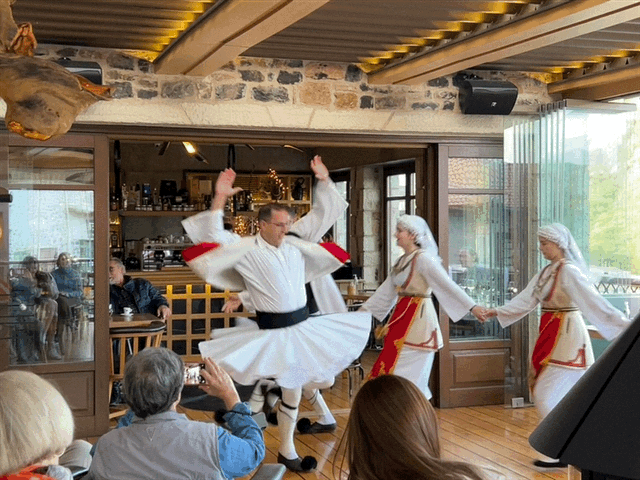Rick Steves Athens & The Heart of Greece

Λαγκάδια
Peloponnese to Lagkadia Day 4
Today we are crossing from mainland Greece to the Peloponnese Peninsula. Everywhere we look is amazingly beautiful. We make our way through the Amfissa olive groves (1.2 million trees!) to the Gulf of Corinth; we pass by fish farms, Venetian fortresses, and reach the Peloponnese Peninsula over a magnificent modern bridge. Of course, there's a coffee stop this morning, as well!


Amfissa Olive Grove: sections are owned by many different families; the olives are taken to the olive mill and the mill keeps 20% as payment.

Fish farms (Aquaculture) in the Gulf of Corinth, highly exported in the EU.

We spot a 15th century Venetian fortress in the hill town of Nafpaktos, (once called Lepanto). The Battle of Lepanto in 1571, a naval battle between Christian (Catholic) forces and Ottomans, where the Ottomans were defeated.
In the background is the beautiful Antirio-Rio bridge (the Charilaos Trikoupis Bridge) that we will be crossing.
One interesting note: Miguel de Cervantes (Don Quixote) fought in the battle of Lepanto! He was wounded and lost use of his left hand.
Rick Steves guides always know the BEST stops along the route! It's time for coffee and a snack and we are like (good) kids in a candy store...




As we cross the bridge, we spot another fortress at Antirio, this time at a strategic position on the water. A similar fortress is on the opposite side in Rio.
We arrive at the town of Diakopto, where it's time to board our train. Officially called the Odontotes Rack Railway (meaning literally "train with teeth." This is a train with cog wheels). Our journey takes us through the Vouraikos Gorge, a 20km long rail journey. The railway links the towns of Diakopto and Kalavryta, and was completed 125 years ago.
The Vouraikos Gorge is very scenic; the tracks cut through the mountains and follows along the river. The railway is really a lifeline for people living in the mountains. Charilaos Trikoupis, prime minister of Greece at the time, was responsible for creating these local railways (note his name - the Rio - Antirio bridge is named for him).



There is also the possibility of WALKING along the tracks! The E4 trail follows the tracks; you can do it all, sections of it. Of course, you may want to walk downhill, so start in Kalavryta!


.jpg)
Our bus met us in Kalavryta; the scenery is just as beautiful on this side of the gorge. We drove past the Place of Sacrifice Memorial; on December 13, 1943, the Germans proceeded in the killing of the entire male population of Kalavryta, 438 men of all ages, and the total destruction of the town.
There were only 13 male survivors.

Our afternoon included a lunch stop at a family run Trout Farm; the food was excellent and the scenery was outstanding. However, many of us (me included) needed a lesson in how to cut and eat a fresh trout! Apostolos was kind enough to show us the correct technique. We had a great time trying it ourselves!




.jpg)

We finally arrive at our hotel in Lagkadia. the hotel Kentrikon. The whole village is built on the side of the mountain. It's time to relax, a night of food, wine and dance.




The mountain roads here were built in the 50s and 60s, the villages before then were very isolated, so the Greek countryside (in Apostolos words) is still very virgin.
Greek dances were a way for young people to see each other, since the families in the area were so isolated. They would use the dances to meet, and find a wife or husband; they would see a potential mate dancing in the circle, and then ask about them! Kind of an old fashioned swipe right, swipe left...

